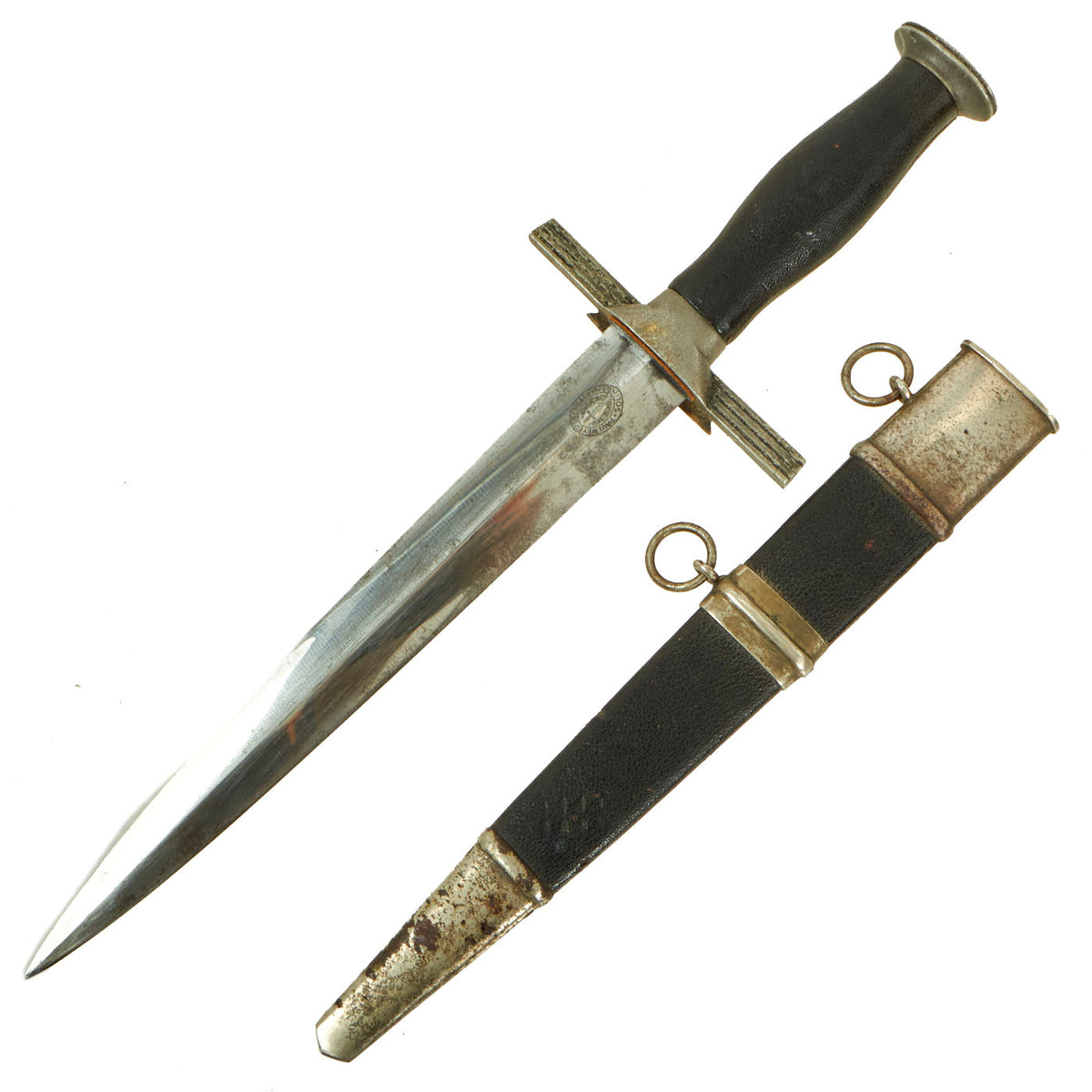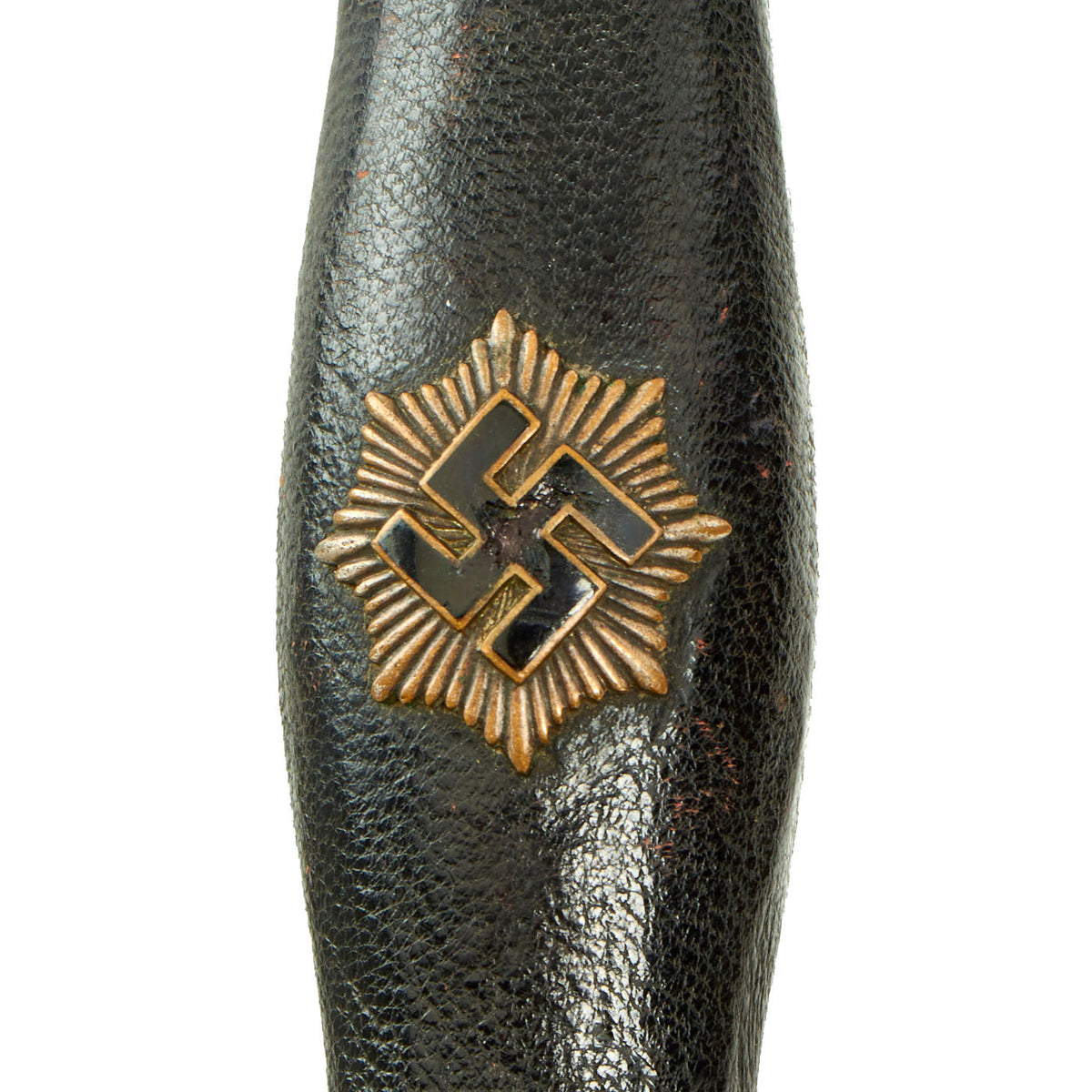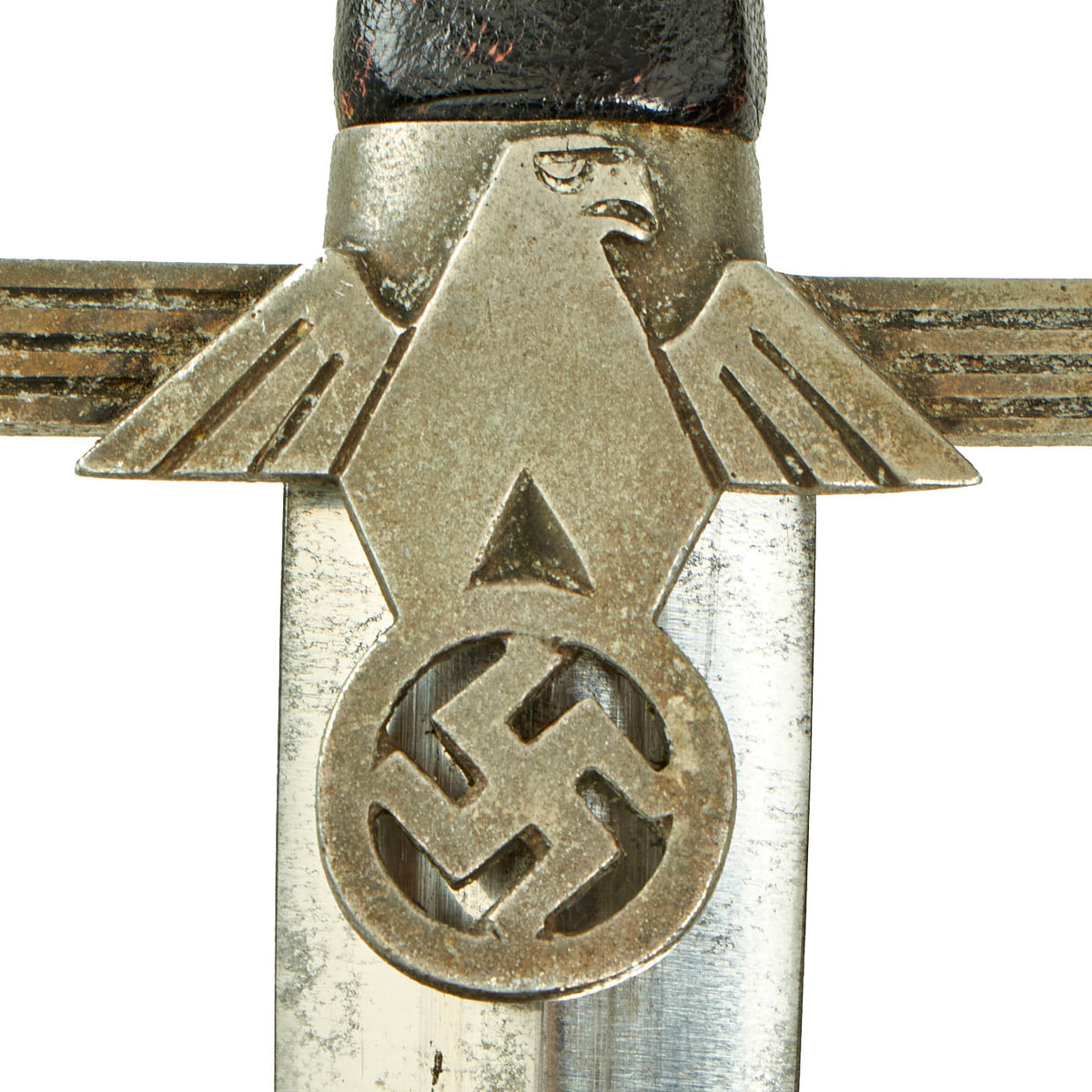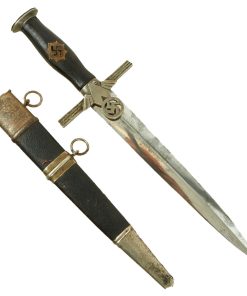Original German WWII 2nd Model RLB Officer’s Dagger by Paul Weyersberg with Scabbard Original Items
$ 2.195,00 $ 548,75
Original Item: Only One Available. This RLB Officer’s Dagger is in very good condition throughout. The hilt mounts are the nickel-plated zinc alloy type, and they have faded to a lovely oxidized patina throughout. The pommel is in the characteristic RBL Officer’s flattened shape with an equatorial band and has only light wear to the tip.
The crossguard features a stubby-winged Art Deco-style eagle clutching a smooth wreath and swas. Unlike the EM/NCO dagger, the crossguard on the officer’s dagger is longer and ends with slightly angled cuts, giving a much more “boxy” look.
The grip is a fine example, which retains a lovely black “Moroccan Leather” covering. There is only light wear and light finish loss, with the side seam still fully glued down. The insignia is the style with a background sunburst. Some of the silvering has worn from the surfaces, revealing the brass base metal beneath. The enamel swas has taken a hit in the center, removing some of the enamel, but we don’t see any metal showing so it has not completely flaked away.
The blade of this dagger is in very good condition, with a mostly bright finish and retaining the original factory crossgrain throughout the blade. This texture is iconic, and is the definitive identifying characteristic for a real WWII German Blade. There are areas of light staining on both sides, but no signs of major polishing or sharpening. There are some runner lines but nothing unexpected. The tip of the blade remains needle-like, with no sign of denting or wear.
This great example was made by Paul Weyersberg of Solingen, the legendary “City of Blades” in western Germany. The reverse ricasso is etched with PAUL WEYERSBERG & Co. / SOLINGEN in double ovals around the firms trademark “Sword-and-Wreath” logo, which was the only marking they used during the Third Reich era. This company was one of many in Solingen owned by members of the Weyersberg family. The company survived the war, but ceased production in 1955. For more information please see GERMAN KNIFE AND SWORD MAKERS by J. Anthony Carter. The original leather blade washer is in place.
The scabbard shell is straight throughout. It is covered in Moroccan leather having the same color and grain as the grip, and this leather is also in very good condition. There is a bit of scuffing and tearing, and there is some lifting at the seam on the side. The steel based silver mounts reflect quite a bit of patina and do not look to have been ever cleaned. They are retained by flush mount side screws, which show no turning or deformation.
A very nice Paul Weyersberg example of the rare RLB Officer’s dagger, always hard to find in such nice condition!
Specifications:
Blade Length: 9 5/8″
Blade Style: Spear Point Dagger
Overall length: 14 1/2“
Crossguard: 4”
Scabbard Length: 10 1/2″
The Reichsluftschutzbund (RLB) (National Air Raid Protection League) was an organization in NSDAP Germany in charge of air raid precautions in residential areas and among smaller businesses. The RLB was organized by Hermann Göring in 1933 as a voluntary association. Existing volunteer air raid precaution associations were forced to merge with RLB. In 1939 the RLB became a Körperschaft des öffentlichen Rechts (quasi-autonomous non-governmental organization), while in 1944 it became an affiliated organization of the NSDAP Party. RLB was dissolved by the Allied Powers after the end of World War II. Its successor in the Federal Republic of Germany was the Bundesverband für den Selbstschutz.
The RLB was in charge of educating and training ordinary German men and women in civil defence procedures necessary for the basic level of local self-help of the civil population against air raids. The local level was formed around air raid wardens and operated in small first intervention squads. The training include fire fighting, protection against chemical weapons, communication procedures and preparation of houses and apartments against air raids.
In 1939 the RLB had about 15 million members, 820 000 volunteer functionaries (of which 280,000 women) and 75,000 local units. The membership was trained at 3,800 civil defense schools with 28,000 instructors.
– RLB was led by a Präsidium, whose president, and vice president and chief of staff, were active duty general officers of the Luftwaffe. The presidium was in itself a department immediately subordinated to the Ministry of Aviation.
– Coterminous with each Luftgaukommando (air district command) was a RLB-Gruppe (RLB-group) under a leader aided by 46 full-time staff members.
– For each Regierungsbezirk, there was a RLB-Bezirksgruppe (regional group).
– The basic organization was the RLB-Revier, one for each police precinct in the cities, or the RLB-Gemeinde-Gruppe, one for each urban or rural municipality for the rest of the country. In the case of a city with several precincts, the citywide organization was called an RLB-Ortsgruppe (local group). Several municipal groups formed an RLB-Ortskreisgruppe, one for each Landkreis. Each Ortsgruppe and Ortskreisgruppe had a leader and a staff of nine members, of which five where full-time salaried employees.
– The basic organizations had a varied number of Untergruppen (sub-groups) divided into Blocke (blocks) under Blockwarte (block wardens) which controlled and liaised with a number of Luftschutzgemeinschafte (air raid protection communities) under Luftschutzwarte (air raid wardens). Each community consisted of an apartment building or several smaller buildings, although a large apartment complex could have several communities. In addition to the warden, the community should have an assistant warden, house fire fighters, helpers and messengers as a first intervention squad. Duty in these squads were compulsory (Notdienstpflicht) for the civilian population.
Fast Shipping with Professional Packaging
Thanks to our longstanding association with UPS FedEx DHL, and other major international carriers, we are able to provide a range of shipping options. Our warehouse staff is expertly trained and will wrap your products according to our exact and precise specifications. Prior to shipping, your goods will be thoroughly examined and securely secured. We ship to thousands clients each day across multiple countries. This shows how we're dedicated to be the largest retailer on the internet. Warehouses and distribution centres can be located throughout Europe as well as the USA.
Note: Orders with more than one item will be assigned a processing date depending on the item.
Before shipping before shipping, we'll conduct a thorough inspection of the items you have ordered. Today, the majority of orders will be delivered within 48 hours. The delivery time will be between 3-7 days.
Returns
The stock is dynamic and we cannot completely manage it because multiple stakeholders are involved, including our factory and warehouse. So the actual stock may alter at any time. It's possible that you may not receive your order once the order has been made.
Our policy is valid for a period of 30 days. If you don't receive the product within 30 days, we are not able to issue a refund or an exchange.
You can only return an item if it is unused and in the same state as the day you received it. You must have the item in its original packaging.
Related products
Uncategorized
Uncategorized
Uncategorized
Uncategorized
Uncategorized
Uncategorized
Band of Brothers ORIGINAL GERMAN WWII Le. F.H. 18 10.5cm ARTILLERY PIECE Original Items
Uncategorized
Uncategorized
Uncategorized
Uncategorized
Uncategorized
Uncategorized
Armoured Fighting Vehicles of the World: AFVs of World War One (Hardcover Book) New Made Items
Uncategorized
Uncategorized
Uncategorized
Uncategorized
Uncategorized
Australian WWII Owen MK1 Machine Carbine SMG Custom Fabricated Replica with Sling Original Items
Uncategorized












































































